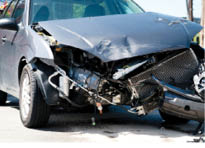Canadian Journal of Neurological Sciences
November 2003; Volume 30, No. 4; pp. 320-325
Michel Beaudry, J. David Spence
From the Department of Clinical Neurological Sciences, University of Western Ontario, London, Canada.
SIGNIFICANT POINTS FROM THIS ARTICLE:
1) Recent neck trauma may cause extracranial carotid and vertebral dissection.
2) Genetic abnormalities of collagen, elastin and other supporting elements in the blood vessel wall may predispose the patient to carotid and vertebral artery dissection with even minor trauma such as sneezing or Valsalva maneuvers.
3) When symptoms are delayed after trauma, the connection between trauma and vascular events are difficult to recognize. The longest described (in the literature) delay between trauma and onset of vertebrobasilar symptoms is two months.
4) “Delays of 7 weeks after injury and 37 days after a motor vehicle accident (MVA) have been reported for the vertebrobasilar distribution, and delay of many years has been described in the carotid artery distribution.”
5) When vertigo is experienced following vertebral artery dissection, it is “often difficult for the attending physician to think of cerebral vascular problem as opposed to a vestibular problem, particularly in a young patient.”
6) Migraine can produce visual symptoms indistinguishable from those due to transient ischemia in the posterior cerebral artery territory, and migraine can also be triggered by trauma.
7) These authors documented 80 cases of cervical artery dissection over a 20 year period, and found the following:
 8) “Several patients had a motor vehicle accident, and then had further vascular injury by neck manipulation.” [This suggests that absent the initial MVA, the chiropractic manipulation would not have been associated with the ischemia].
8) “Several patients had a motor vehicle accident, and then had further vascular injury by neck manipulation.” [This suggests that absent the initial MVA, the chiropractic manipulation would not have been associated with the ischemia].
9) “The severity of the initial trauma was substantial for some patients, but was mild for many.”
10) “We have been struck by how often neurologists and neurosurgeons miss or refuse to recognize the diagnosis, and suspect that it is often dismissed because of an aversion to medicolegal cases and legal practitioners…. The unwillingness to diagnose this condition of traumatic vertebrobasilar ischemia in the setting of MVAs is in marked contrast to the willingness, even eagerness, to diagnose it in the setting of chiropractic manipulation, often by the same physicians who are unwilling to recognize it in MVA cases.”
11) “With extension of the neck, especially when adding a rotational component, the vertebral artery is stretched and/or compressed in the foramen transversarium of the Atlas or before it pierces the atlanto-occipital ligament.”
12) Trivial neck turning while looking backward while backing up a car or during swimming, yoga or archery, or a Valsalsva maneuver during birthing, may initiate vertebral artery dissection.
13) Neck extension during surgical intubation has been shown to injure the vertebral artery.
14) Vertebrobasilar ischemia may occur after extension of the neck over the edge of a hairdresser’s sink while having hair shampooed.
15) 72% of people have an asymmetric circulation, usually having one hypoplastic vertebral artery.
16) Rotation and extension of the neck obstructs flow in a dominant vertebral artery, which may predispose the patient to problems when the collateral circulation is poor.
17) Rarely, osteophytes may compress a vertebral artery, causing recurrent transient ischemic attack events.
18) Instability of the alar or other atlanto-axial ligaments may cause episodes of vertebrobasilar ischemia provoked by turning of the head.
19) Arterial spasm may lead to ischemic symptoms, and pre-traumatic spasm increases the incidence of dissection.
20) Migraine may cause ischemia symptoms similar or identical to artery dissection.
21) Artery dissections are best shown with either MRA (magnetic resonance angiogram) or ultrasound.
22) “Traumatic vertebrobasilar ischemia may present up to four and nearly five years after the neck injury. It is, therefore, probably much more common than is currently suspected.”
23) “Though chiropractic manipulation is perhaps the best-known cause, it is important to recognize that MVAs are a much more common cause, which is often missed.”
COMMENTS FROM DAN MURPHY
• All chiropractors should be aware that motor vehicle collisions are a prime (and possibly the primary) trigger of vertebral artery dissections.
• The symptoms of post-traumatic vertebral artery dissections can be delayed for hours, days, weeks, months and even years.
• The primary mechanism for vertebral artery dissection is a combination of cervical extension and rotation.
• There appears to be an increased risk of dissections in patients with migraines.
Dr. Dan Murphy graduated magna cum laude from Western States Chiropractic College in 1978. He received Diplomat status in Chiropractic Orthopedics in 1986. Since 1982, Dr. Murphy has served part-time as undergraduate faculty at Life Chiropractic College West, currently teaching classes to seniors in the management of spinal disorders. He has taught more than 2000 postgraduate continuing education seminars. Dr. Murphy is a contributing author to both editions of the book Motor Vehicle Collision Injuries and to the book Pediatric Chiropractic. Hundreds of detailed Article Reviews, pertinent to chiropractors and their patients, are available at Dr. Murphy’s web page, www.danmurphydc.com.
